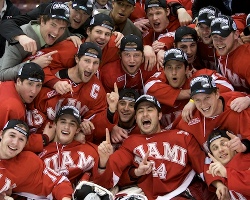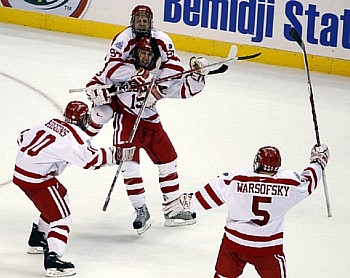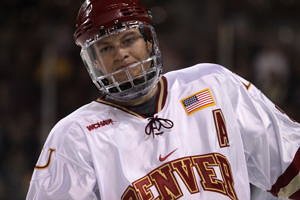The 2009-2010 CCHA: The Direction of Change
“The moment of change,” said poet Adrienne Rich, “is the only poem.” If there’s even the smallest grain of truth in Rich’s statement, then CCHA fans are in for plenty of poetry in the coming months.
Bowling Green has a new head coach. Nebraska-Omaha has a new head coach. Nebraska-Omaha is leaving for the WCHA at the start of the 2010-11 season. The CCHA rejected Alabama-Huntsville’s membership application, guaranteeing that the league membership will fall to 11 teams next season if nothing there changes. The CCHA is awarding three points for every game.
Five changes, five poems. Funny, but all that poetry feels like uncertainty to me — or dizzying chaos. So let’s focus on the comforting consistency of the magic number three: for the third consecutive season, a CCHA team has ended its campaign playing for the NCAA championship.

Miami ran through a pair of WCHA teams in WCHA territory en route to an NCAA regional championship last season (photo: Jim Rosvold).
Congratulations to the Miami RedHawks on their incredible ride to the 2009 title game. While every CCHA fan would like to forget the last minute of regulation play — and every bit of overtime — in that 4-3 loss to Boston University, every fan of CCHA hockey has to be thrilled with having watched three teams from three different programs play for a title in three years. That the programs represented three different CCHA states is a delightful bonus.
“We expect several of our teams to be national powers this season,” league commissioner Tom Anastos said at this year’s media day. “We’re very excited about the depth of our league.”
Said Notre Dame coach Jeff Jackson, “There are probably five or six teams for sure that could potentially win the conference and go on to the NCAA tournament.”
Six teams that could make the NCAA tournament come easily to mind — a full half the league’s participants.
Small Change
The media and coaches were fairly evenly split about who would take the conference, but the preseason pick came down to two teams: Michigan and Notre Dame. Rounding out the top three vote-getters was Miami, followed by Ohio State and Northern Michigan — all familiar names in a pretty predictable pattern.
Changing Tunes
As happy as most college hockey fans are to have Dean Blais back, losing the program he’ll be coaching to the WCHA in 2010-11 is a big blow to the league. The cynic in me wonders if his hiring wasn’t the deciding factor in the Mavericks’ decision to jump to a league that once wanted nothing to do with them. Blais was head coach at North Dakota from 1994 to 2004, where he won two national championships.
And as happy as most of us are to have Blais coaching college hockey again — which is exactly where he belongs — it’s hard to say goodbye to Mike Kemp, the man who built UNO hockey and a real class act.
The league lost another class act in Scott Paluch, the beleaguered Bowling Green head coach who left coaching altogether to be a regional manager of USA Hockey’s American Development Model. Paluch — or “Pooch,” as he is known to many — just never seemed to have an easy time of it in BG, and given what we know now about the financial instability of the program, perhaps his critics will have a better understanding of what he was up against.
Dennis Williams will serve as interim head coach for the Falcons this season. Williams, who served as a BG assistant coach last season, was head coach at Neumann College from 2004 to 2007, and served as an assistant in Huntsville for a year before returning to his Bowling Green, his alma mater (1997-2001).
The Point of Change
Or rather, changes in the way points awarded.
No, CCHA fans, the league didn’t vote in the offseason to dump the shootout, alas. But the CCHA has — much to its credit — revisited the way points are awarded given that the shootout is here to stay.
Each game will now be worth three points. When a team wins outright in regulation or overtime, it will earn three points. If a game goes to a shootout after an overtime tie, the team winning the shootout will get two points; the team losing the shootout will earn one point.
“I think it is a more fair system,” Anastos said. “We talked about it two years ago before we implemented the shootout, but last year we had some really meaningful data that we could extrapolate to from the current system into the new three-point system.”
Short Changed?
Will Alabama-Huntsville be admitted to the CCHA after having been rejected by the league in the offseason? Well, we don’t have to think about that right now, do we?
Unless You’re the Lead Dog…
… the view never changes much. What an exciting season it would be if that view were to change for one or more of the teams that has spent a good part of this decade mired in the bottom half of league standings. Falcons, Lakers, Broncos — are you listening?
The More Things Change, the More They — Well, You Know the Rest
The changes to the CCHA are immediate as well as inevitable, and they may map what’s in store for the future of college hockey. “There is nothing wrong with change,” said Winston Churchill, “if it is in the right direction.”
What direction the CCHA’s changes will take remains to be seen for the 2009-10 season and beyond, but in the meantime, there’s a good deal of hockey to be played.
Here’s a look at each team in the order in which I’ve predicted them to finish, and let me give a disclaimer here right at the start: I expect the difference in points between teams in the middle of the pack — traditionally from Nos. 5 through 10 — to be very, very small. As we’ve seen in recent years, the CCHA’s midsection has often provided the most interesting, season-ending storylines. It’s just tough to pick this league, and no one has any idea of how the new points system is going to affect the mix.
Individual team previews can be accessed by clicking on each team’s name. Whatever you do, don’t take these picks to the bank.
1. Notre Dame
Head coach: Jeff Jackson, fifth season
2008-09 record: 31-6-3, 21-4-3-3 CCHA
2008-09 CCHA finish: first
2008-09 season ender: 5-1 loss to Bemidji State, Midwest Regional semifinal
2009-10 predicted ceiling/basement: first/third
Quotable: “Our speed and our skill has improved quite a bit, and I am excited about us playing an up-tempo game,” says Jackson. Given the other weapons in Notre Dame’s arsenal, an up-tempo game could be a real killer.
2. Michigan
Head coach: Red Berenson, 26th season
2008-09 record: 29-12-0, 20-8-0-0 CCHA
2008-09 CCHA finish: tie second
2008-09 season ender: 2-0 loss to Air Force, East Regional semifinal
2009-10 predicted ceiling/basement: first/third
Quotable: “We are a little more settled in goal and a little deeper on defense,” says Berenson. If the Wolverines shore up both the goal and defense, they could be unstoppable.
3. Miami
Head coach: Enrico Blasi, 11th season
2008-09 record: 23-13-5, 17-7-4-2 CCHA
2008-09 CCHA finish: tie second
2008-09 season ender: 4-3 OT loss to Boston University, National Championship
2009-10 predicted ceiling/basement: first/fourth
Quotable: “Our guys have really done a good job of putting the title behind them and understanding that it was a great experience,” says Blasi. How the RedHawks use that experience will be a real test for this program — and may propel it back to where it was a year ago.
4. Ohio State
Head coach: John Markell, 16th season
2008-09 record: 23-15-4, 13-11-4-3 CCHA
2008-09 CCHA finish: fifth
2008-09 season ender: 8-3 loss to Boston University, Northeast Regional semifinal
2009-10 predicted ceiling/basement: third/eighth
Quotable: “For the first time ever, they are going to allow the students in for free,” says Markell. This could be a big deal for OSU … if the students realize that there’s more to Buckeye sports than football, that is.
5. Northern Michigan
Head coach: Walt Kyle, eighth season
2008-09 record: 19-17-5, 11-12-5-3 CCHA
2008-09 CCHA finish: sixth
2008-09 season ender: 2-0 win over Alaska, CCHA Third-Place game
2009-10 predicted ceiling/basement: fourth/eighth
Quotable: “The last couple of years we’ve had slow starts, but we’ve had young teams,” says Kyle. Given how high the Wildcats are picked this season, it’s pretty clear that many people believe that NMU will start a little quicker with a veteran group.
6. Nebraska-Omaha
Head coach: Dean Blais, first season
2008-09 record: 15-17-8, 8-13-7-3 CCHA
2008-09 CCHA finish: tie seventh
2008-09 season ender: 1-0 loss to Notre Dame, CCHA Quarterfinal second game
2009-10 predicted ceiling/basement: fifth/10th
Quotable: “I’m very happy to be back in college hockey,” says Blais. We’re all pretty happy to have you in the CCHA, Coach. Too bad you’re only with us for a season.
7. Alaska
Head coach: Dallas Ferguson, second season
2008-09 record: 17-16-6, 13-10-5-3 CCHA
2008-09 CCHA finish: fourth
2008-09 season ender: 2-0 loss to Northern Michigan, CCHA Third-Place game
2009-10 predicted ceiling/basement: fourth/10th
Quotable: “If you do things well away from the puck, hopefully, you will get the puck back,” says Ferguson. Wise words from a man who in just one season changed the culture of Nanook hockey.
8. Michigan State
Head coach: Rick Comley, eighth season
2008-09 record: 10-23-5, 7-17-4-3 CCHA
2008-09 CCHA finish: tie 10th
2008-09 season ender: 8-2 loss to Northern Michigan, CCHA First Round second game
2009-10 predicted ceiling/basement: fifth/ninth
Quotable: “There will be life after Jeff Lerg,” says Comley. Given the many games last season when Lerg exhibited the only signs of the life for the Spartans, that’s encouraging.
9. Ferris State
Head coach: Bob Daniels, 18th season
2008-09 record: 12-19-7, 9-14-5-2 CCHA
2008-09 CCHA finish: ninth
2008-09 season ender: 5-2 loss to Nebraska-Omaha, CCHA First Round second game
2009-10 predicted ceiling/basement: sixth/10th
Quotable: “The answers to the offensive difficulties lie within our locker room right now,” says Daniels. If the Bulldogs want to climb out of the middle of the pack, they must score more goals — and more consistently.
10. Lake Superior
Head coach: Jim Roque, fifth season
2008-09 record: 11-20-8, 7-15-6-1 CCHA
2008-09 CCHA finish: tie 10th
2008-09 season ender: 3-1 loss to Western Michigan, CCHA First Round third game
2009-10 predicted ceiling/basement: eighth/12th
Quotable: “The last few years have been rather disappointing for us,” says Roque. Seven league wins in each of the last two seasons is a record this team can definitely improve upon.
11. Western Michigan
Head coach: Jim Culhane, 12th season
2008-09 record: 14-20-7, 9-13-6-2 CCHA
2008-09 CCHA finish: tie seventh
2008-09 season ender: 6-1 loss to Michigan, CCHA Quarterfinal second game
2009-10 predicted ceiling/basement: eighth/12th
Quotable: “I liked the second half of last season and we would like to build off of those successes,” says Culhane. That second half included nine regular-season wins, a good foundation.
12. Bowling Green
Head coach: Dennis Williams, first season
2008-09 record: 11-24-3, 8-19-1-0 CCHA
2008-09 CCHA finish: 12th
2008-09 season ender: 7-1 loss to Ohio State, CCHA First Round second game
2009-10 predicted ceiling/basement: eight/12th
Quotable: “It’s an exciting time for Bowling Green hockey with the announcement of a fundraising campaign,” says Williams. The exciting thing for most of us is that Bowling Green will continue to play hockey, period.


